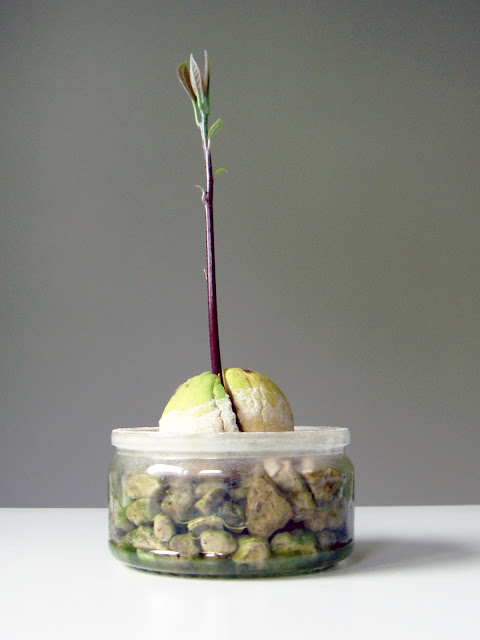order: laurales
family: lauraceae
genus: persea
species: americana
cultivar: 'Hass'
Avocado is a subtropical evergreen tree belonging to the laurel family and growing to about 30m at maturity. Besides its delicious and nutritious fruits, the trees are appreciated for its admirable foliage in different shades of green and red. Its colour keeps on changing throughout the growing season, and is thus never boring to look at.
I started two plants in late winter this year from stones that I obtained from avocado fruits. Although both fruits had been labeled as 'Hass' cultivar, one stone is significantly bigger than the other. For experiment purpose, I peeled the bigger stone completely naked and left the smaller one intact. Both seeds were allowed to sit halfway in a glass of water, supported by light pumice granules. Subsequently I placed the glasses on top of the heating unit.
The smaller stone managed to strike within the first week itself whereas the big fat one only started to show sign of growing in spring. They have been transplanted into pots with compost. Although the first one was 5 leaves ahead of the second in terms of initial growth, the fat one managed to take over to become taller. The smaller one has a more compact growth with shorter internodes. Although smaller, it has more leaves. I love them both. I'm anticipating their first branches.
family: lauraceae
genus: persea
species: americana
cultivar: 'Hass'
Avocado is a subtropical evergreen tree belonging to the laurel family and growing to about 30m at maturity. Besides its delicious and nutritious fruits, the trees are appreciated for its admirable foliage in different shades of green and red. Its colour keeps on changing throughout the growing season, and is thus never boring to look at.
I started two plants in late winter this year from stones that I obtained from avocado fruits. Although both fruits had been labeled as 'Hass' cultivar, one stone is significantly bigger than the other. For experiment purpose, I peeled the bigger stone completely naked and left the smaller one intact. Both seeds were allowed to sit halfway in a glass of water, supported by light pumice granules. Subsequently I placed the glasses on top of the heating unit.
The smaller stone managed to strike within the first week itself whereas the big fat one only started to show sign of growing in spring. They have been transplanted into pots with compost. Although the first one was 5 leaves ahead of the second in terms of initial growth, the fat one managed to take over to become taller. The smaller one has a more compact growth with shorter internodes. Although smaller, it has more leaves. I love them both. I'm anticipating their first branches.













